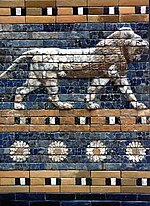This article needs additional citations for verification. (March 2008) |
| Part of a series on the |
| Culture of Iraq |
|---|
 |
| History |
| People |
| Languages |
| Cuisine |
| Religion |
| Art |
| Literature |
| Music |
| Sport |
Iraq was home to the first television station in the Middle East, which began during the 1950s. As part of a plan to help Iraq modernize, British telecommunications company Pye Limited built and commissioned a television broadcast station in the capital city of Baghdad.[1] Following the 2003 US-led invasion of Iraq, the Iraqi state media collapsed. In June 2004, a Communications and Media Commission was set up to approve and grant license for all the country's media.[2] By 2011, Iraq was the headquarters of 49 free-to-air satellite channels, one of the highest numbers in the region.[2] Until 2003, satellite dishes were banned in Iraq, and there was a limited number of national terrestrial stations.[2] After 2003, the sale of satellite dishes surged, and free-to-air channels entered the market.[2] There are 17 terrestrial channels, of which one is funded by the US government through the U.S. Agency for Global Media (Alhurra-Iraq), and seven are owned by the state broadcaster Iraqi Media Network.[2] In March 2011, Al Jazeera was granted rights to resume operations after being banned in 2004.[2] Plans were established to set up a free-media zone based in Baghdad, the Baghdad Media City, by the end of 2014.[2]
- ^ Cafe, Kirt Blattenberger RF. "Middle East Gets Its First Television Station, June 1955 Popular Electronics". Retrieved 7 May 2021.
- ^ a b c d e f g "Arab Media Outlook 2011-2015" (PDF). 2012. pp. 179–180. Archived from the original (PDF) on 27 March 2019. Retrieved 14 February 2013.